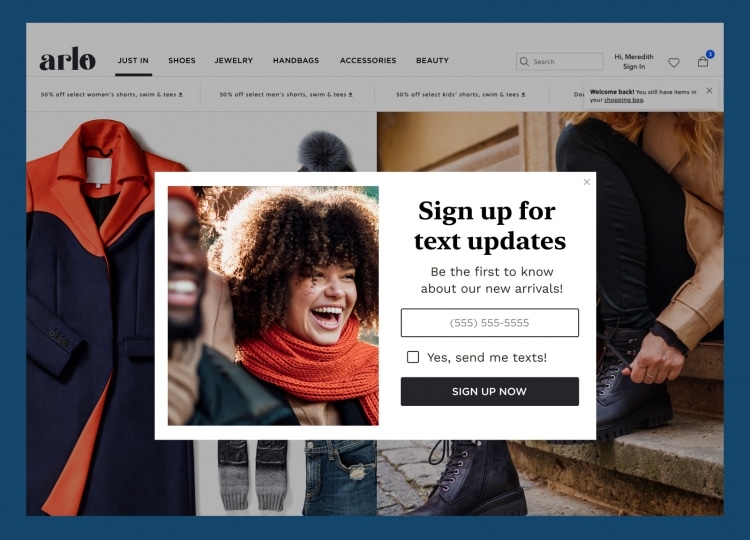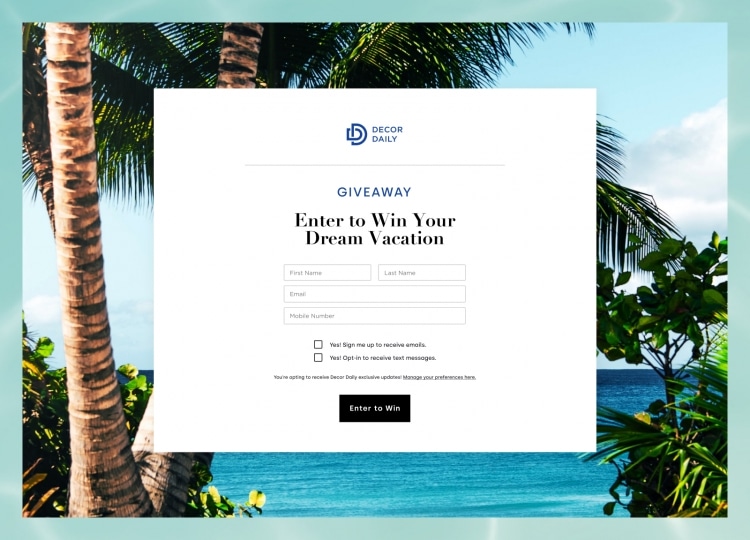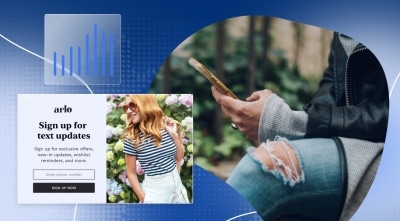Mobile
Grow Your Holiday Sales With SMS Marketing: Four Tips To Build Your List Now
November 16, 2022

Grow Your Holiday Sales With SMS Marketing: Four Tips To Build Your List Now
SMS marketing has fast become a main contender when prioritizing which channels to choose to achieve your business goals, and how best to reach your customers. Which is not surprising considering consumer sentiment around receiving text messages from brands has evolved over recent years, with 91% of customers saying they’re interested in signing up to receive SMS from a brand.
Capturing the right data for all of your marketing channels, for every customer, can be overwhelming, time-consuming, and costly. But, it’s also worthwhile! When factoring in the engagement SMS marketing drives – 95% of text messages are read and responded to within three minutes of receipt – it further highlights SMS as an important channel to use within your marketing mix, particularly for time-sensitive events like the holiday season.
But, where should you start when building your SMS list? Building an SMS marketing list is about establishing trust through clear communication while giving your customers a reason to sign up. Subscribers want value in exchange for providing information about their preferences. So show your audience why sharing their cell phone number is a good deal for them, not just you.
Read our top 4 tips for growing your list, now!
1. Tell Subscribers What to Expect
Avoid customer annoyance -and a high unsubscribe rate, by clearly communicating what someone is signing up for before asking for the person’s phone number. This means telling a customer how often you’ll text and what kinds of notifications you’ll send, whether it’s delivery information or exclusive coupons. After setting those expectations, you’ll need to stick to them.
Consumers are savvier about privacy than ever before. They expect plain language explaining how you’ll use their phone number—and promising you won’t sell it. You should also tell them how they can get off your SMS subscriber list. Make sure it’s clear they can unsubscribe at any time without having to jump through hoops.
It can be difficult to share your company’s privacy policy information in every interaction. Set up a page people can visit to learn the details of your SMS program. For example, The Frye Company links to a privacy policy written in simple language from the page it uses to capture mobile phone numbers. Another option is to send the link to customers’ phones as part of the opt-in message, so they’ll know all the terms before joining.
2. Keep it Simple (for you and your subscribers)
As a rule, the easier it is for your customers to share their information with you, the more likely they will be to do so. A seamless data-capturing experience should be simple to execute for you as a marketer, as it is for customers to fill out – so you can focus on driving value and delivering a consistent and compelling customer journey.
Sailthru Overlays, for example, is an excellent tool for driving engagement on your site via targeted messages that can be turned into data-capturing moments. Overlay modals or banner bars can be placed on your website as an inviting way for your customers to enter their mobile numbers and consent to receiving SMS messages from you. These can be customized to bring to life your brand and tone-of voice, to enhance the brand experience, while driving results for your business.
In this example below, we use an in-context overlay modal on the New Arrivals page to incentivize SMS opt-in, using the value driver of “be the first to hear about our new arrivals.”

Another tool that allows for simplified data capture is Sailthru’s Hosted Pages. They’re ideal for collecting mobile numbers, email addresses, and for your customers to manage their opt-ins and preferences. This data is then conveniently added to your custom profile fields to use for your cross-channel marketing campaigns.
In the below campaign, we highlight how you can direct both your email and social campaigns to a hosted page promoting a giveaway as a way to grow your email and SMS sign-ups.

3. Offer Incentives
Your customers won’t sign up without a good reason to do so. There are five main types of incentive programs businesses use.
VIP club or insider program
An exclusive VIP program should offer perks your customers can’t get any other way. Access to presales, birthday rewards, and free shipping are always popular options.
One benefit of tying your SMS list to an ongoing program is that customers will have an incentive to stay subscribed to your texts. VIP and insider programs can also increase customer loyalty when members feel they’re truly getting something special from the experience.
Exclusive text message deals
If you don’t have the capacity to support a full VIP program, you can create an ongoing text message deals program. The offers you send should not be available to anyone who’s not on your SMS marketing list. Customers won’t be happy if they find out they gave you their phone number for the same “exclusive” coupons you’re sending out in email blasts.
This structure offers the same ongoing incentives as a VIP club but at a lower cost. However, it still takes some effort to administer. Offers need to feel new and exciting, so customers stay engaged with your text messages.
Checkout bonuses
Offering benefits to customers who are already committed to buying from you can help boost in-the-moment conversions. Try trading a discount code for your customers’ phone numbers during the checkout process. E-commerce businesses might also consider offering free shipping to customers who join your SMS contact list.
While a checkout bonus might be good for winning sign-ups at times of high customer engagement, they don’t offer ongoing benefits. There’s always the risk shoppers will sign up to get the discount and then immediately unsubscribe. You’ll have to find another way to offer continuing value via text marketing.
Contest entries
People love free things. Simply ask customers to sign up for your SMS list in exchange for an entry into a giveaway. You’re free to set whatever terms and criteria for winners you want. The most important thing is an opportunity that’s too good to pass up.
Like checkout bonuses, contest entries don’t offer an ongoing benefit, so you’ll have to follow them up with more engaging content to decrease the likelihood people will unsubscribe. Many businesses foster goodwill with every entrant by offering some form of consolation prize—like a coupon code—to anyone who doesn’t win.
Make sure you tell entrants they’re opting into future marketing messages when they enter your contest or you’ll be violating the TCPA.
In-Store Events
Offering consumers a chance to sign up while they’re browsing your store or at the checkout register gives them the opportunity to ask staff about your program. If you attend or host events, consider setting up a phone number collection program there. But be sure your in-store staff is well-versed on your SMS incentives, perks and the ease of opting out at any time.
4. Play by the Rules
While this may sound obvious, we cannot stress enough how important it is to only message consumers who have provided explicit consent. Just because someone has opted into your email list doesn’t mean they’ve opted into your SMS list as well. SMS is a separate channel, and you need to get separate permission from each user before you send them an SMS message.
The Telephone Consumer Protection Act (TCPA) can levy fines as much as $500 per violation.
Keep all affirmative consent on record to avoid incurring penalties. Even better, create a double opt-in process. Once someone submits their number for SMS marketing, send a text with a code they must use to receive further communications. Make sure you tell them they might incur text messaging fees from their carrier before they finalize their subscription.
Studies show that an SMS opt-out rate of over 2.2% indicates that customers are unhappy with your text message marketing campaigns. If you’re above this level, double-check your company’s strategy. Maybe your messages need to be more segmented or maybe you are sending too many messages that are repetitive or irrelevant.
Additional compliance policies to keep in mind:
- Messages may only be sent between 8 AM and 9 PM in a customer’s local time.
- Never send marketing text messages to anyone on the national Do Not Call registry.
- Messages must always include your company’s name.
- Messages must always have an easy opt-out option.
- 13 states (AZ, CA, CO, CT, FL, IN, NJ, ND, OK, RI, UT, WA, and WI) have their own laws governing text messages. Make sure to familiarize yourself with the laws that apply to anywhere your consumers may live.
SMS is great for certain marketing efforts, but its limits to message length and reach mean it can’t do everything for you. Combining SMS and email marketing leads to more effective campaigns. The secret is learning how to use each medium according to its strengths. The team at Marigold Engage by Sailthru, here to help you leverage marketing channels, like SMS. Get in touch with our team to learn how to get started.
 |
The State of Brand Loyalty in the U.S. in 2023
Related



